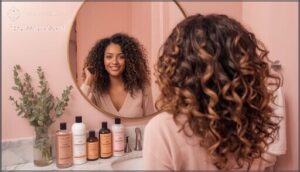This site is supported by our readers. We may earn a commission, at no cost to you, if you purchase through links.

Wavy hair sits in its own category with its own rules, and once you understand how those S-shaped patterns actually work, everything changes. The cuticle structure is different, the moisture needs are different, and yes, the routine needs to be different too.
A proper hair routine for wavy hair respects what makes your texture unique instead of fighting against it, which means you’ll spend less time wrestling with frizz and more time enjoying waves that actually hold their shape.
Table Of Contents
- Key Takeaways
- Things to Know About Wavy Hair
- The Perfect Everyday Wavy Hair Routine
- Creating The Right Wavy Hair Routine for You
- Protecting Your Waves While You Sleep
- How to Maintain Wavy Hair
- Love Your Wavy Hair
- The Curly Girl Method and Its Followers
- What Newbies Like Me Want to Know
- My Curly Girl Method Steps
- My Review of The Curly Girl Method
- Frequently Asked Questions (FAQs)
- What is the best hair routine for wavy hair?
- How do you get wavy hair?
- How do you maintain wavy hair?
- How often should I trim my wavy hair?
- Can I use a blow dryer to style my wavy hair?
- Are there any products I should avoid when styling my wavy hair?
- How can I create more definition in my waves?
- What is the difference between wavy hair and curly hair?
- Can wavy hair be straightened or curled permanently?
- How does diet affect wavy hair health?
- Conclusion
Key Takeaways
- Wavy hair has a unique S-shaped cuticle structure that retains moisture better than curly hair but dries slower, requiring a specialized routine that respects its texture instead of treating it like straight or curly hair.
- The five-step wavy hair routine—cleanse with sulfate-free products, condition and detangle while wet, moisturize and protect with lightweight products, dry to 80% then air-finish, and seal with anti-humidity spray—transforms chaotic waves into defined, frizz-controlled texture.
- Your wave pattern (2A, 2B, or 2C) and hair porosity dictate product choices and wash frequency, with fine waves needing lightweight volume boosters while thicker waves require deep moisture treatments every two weeks.
- Nighttime protection using silk or satin pillowcases reduces morning frizz by 40% and prevents breakage, while protective styles like loose pineapple buns maintain wave definition without damaging your hairline.
Things to Know About Wavy Hair
Your waves aren’t random—they’re coded into the architecture of your hair. Wavy hair forms that signature S-shaped pattern because of how your follicles are shaped, with wave types ranging from loose 2A to more pronounced 2C textures.
Those waves come with cuticles spaced further apart than curly hair, which means better moisture retention but also slower drying times. You’ll notice wavy hair holds about 44% of the population, making it incredibly common.
The catch? Your hair porosity—whether your cuticles are tight, open, or somewhere in between—dictates how your waves absorb and hold moisture. Low porosity resists water but locks it in once hydrated, while high porosity drinks it up fast but loses it just as quickly.
Understanding your specific wave pattern and hair texture is your foundation for frizz control and building a hair care routine that actually works. The structure of your hair is influenced by its keratin protein, which plays a key role in determining its texture and overall health.
The Perfect Everyday Wavy Hair Routine
You’re about to get a game plan that actually works. This routine breaks down into five simple steps that’ll transform your waves from chaotic to controlled.
Let’s walk through each one so you can own your texture.
Step 1: Cleanse
Your waves deserve respect, so skip the harsh sulfates and commit to gentle cleansing that actually works. Proper scalp care means using lukewarm water and sulfate-free formulas that maintain your hair’s natural pH balance without stripping essential oils.
Here’s your cleansing game plan:
- Focus on your scalp – Work shampoo gently with fingertips, not nails, to lift buildup without irritation
- Use a clarifying shampoo every 4-5 washes to remove stubborn product residue
- Massage for 2-3 minutes to boost circulation and distribute natural oils
- Rinse thoroughly with lukewarm water to prevent weighing down your waves
- Let lengths self-cleanse as foam runs down, reducing mechanical stress on fragile strands
This hair routine protects your wave pattern while keeping your scalp healthy and balanced. For best results, consider using curly hair products that are designed to moisturize and nourish your hair.
Step 2: Condition and Detangle
Conditioning is where you’ll actually define those waves—this step feeds your hair the hydration and slip it needs to detangle without damage. Apply lightweight conditioner mid-shaft to ends, then grab a wide-tooth comb or your fingers to work through knots starting from the tips upward. The trick? Always detangle while conditioner is on—this cuts breakage by up to 50% compared to dry combing.
| Conditioning Tips | Detangling Methods | Wave Enhancement |
|---|---|---|
| Use lightweight formulas weekly | Always work on wet, conditioned hair | Squish conditioner upward for definition |
| Deep condition for repair | Start at ends, move to roots | Finger-coil sections while product is wet |
| Rinse thoroughly to avoid buildup | Use flexible wide-tooth tools | Apply leave-in conditioner for frizz control |
Flip your head and squish that conditioner upward—this “squish to condish” move encourages your natural S-pattern while locking in hair moisture.
Step 3: Moisturize, Protect, and Style
After conditioning, your hair’s primed for the styling trifecta—moisture, protection, and hold.
Apply leave-in conditioner or a lightweight conditioning serum while your hair’s still soaking wet, then layer on a heat protectant if you’re diffusing (it cuts water loss by up to 44%).
Lock in moisture balance with a curl-defining cream or flexible-hold gel, using the praying hands method to smooth frizz and accentuate your wave pattern without weighing it down.
Step 4: Dry
Here’s the truth about drying wavy hair—it can make or break your pattern. Blow drying to about 80% dryness on low heat, then letting it finish naturally, gives you the best of both worlds: less time spent soaking wet (which actually damages hair) and defined waves without frizz. Here’s your game plan:
- Microfiber towel squeeze: Gently blot excess water upward to reduce friction and kickstart your wave shape.
- Diffuser on medium heat: Use a claw attachment to lift roots and dry in sections, keeping that nozzle moving to prevent hot spots.
- Air dry the final stretch: Once you hit 80-90% dry, hands off—let those waves set without interference for maximum definition.
Step 5: Finish Off Your Style
Your final move? Lock it all in. Once your waves are 80% dry, grab a lightweight hair serum—argan or almond oil works magic here—and work 2-3 drops through your ends to seal the cuticle and kill frizz before it starts.
Then hit your style with an anti-humidity spray for a 12-hour hold that won’t stiffen. Finish with gentle scrunching to scrunch out the crunch, boosting definition by nearly 30% while keeping movement soft and natural.
Creating The Right Wavy Hair Routine for You
Your waves aren’t one-size-fits-all, and neither should your routine be. Developing a wavy hair routine starts with understanding your specific hair texture—whether you’re dealing with fine 2A waves that need lightweight volume or thicker 2C hair craving serious moisture balance.
Type 2A benefits from frequent washing to control frizz by 25%, while 2B requires conditioning-stage detangling to prevent damage. For 2C, rich biweekly masks boost flexibility by 15%.
Wave enhancement comes from matching products to porosity levels—sulfate-free formulas reduce dehydration by 30%, and targeted ingredients like aloe vera improve frizz control by 26% in humid conditions.
Maintaining wavy hair means adjusting for seasons, activity levels, and your hair’s evolving needs. Creating beachy waves isn’t about following someone else’s blueprint—it’s about owning what works for your texture and lifestyle.
Protecting Your Waves While You Sleep
Your nighttime routine can make or break your waves—literally. Sleep position matters more than most people realize, with side and stomach sleepers experiencing markedly more breakage and split ends from friction.
Swap your cotton pillowcase for silk or satin—studies show silk pillowcases reduce morning frizz by up to 40% while maintaining natural moisture that cotton absorbs. That smooth surface also prevents tangling and keeps your wave pattern intact. If pillowcases aren’t enough, try a satin bonnet or adjustable sleep cap for extra frizz prevention.
Protective hairstyles work wonders for wave preservation. Try a loose pineapple bun on top of your head to maintain volume, or loose braids to reduce friction by about 30%. Just avoid tight ponytails—they stress your scalp and damage your hairline.
Boost nighttime hydration with leave-in conditioner before bed, improving moisture retention by 25%. Your silk pillowcase will help lock in those products overnight, giving you healthier, more defined waves come morning.
How to Maintain Wavy Hair
Maintaining natural waves isn’t about flawlessness—it’s about consistency. Your wavy hair care routine should focus on moisture balance and frizz control without over-handling those gorgeous S-shaped patterns.
Keep your waves thriving with these wave enhancement essentials:
- Limit heat styling to once weekly, reducing moisture loss by 35% while protecting your hair texture
- Clarify monthly with a gentle reset shampoo to remove buildup that weighs down your wave pattern
- Trim every 8-12 weeks to eliminate split ends and maintain bounce—82% of professionals swear by this schedule
- Scrunch with microfiber towels instead of rubbing to encourage volume and definition while preventing frizz
Master these wavy hair styling guide basics and you’ll achieve natural, defined waves that last. Remember, moisturizing shampoos and conditioners plus the right hair product recommendations make all the difference in your wavy hair care routine.
Love Your Wavy Hair
Your waves aren’t some consolation prize between straight and curly—they’re a powerhouse texture with serious styling potential. 76% of people with natural waves report feeling confident rocking their texture, and 87% get more compliments than criticism. That’s not luck, that’s what happens when you stop fighting your hair and start working with it.
Wavy hair isn’t a consolation prize—it’s a powerhouse texture that 76% of people confidently rock, earning more compliments than criticism when you work with it, not against it
Your wavy hair care routine should celebrate what you’ve got, not try to force it into something else. Focus on natural wave enhancement through proper moisture balance and frizz reduction techniques that respect your wave pattern maintenance needs. Styling wavy hair becomes seamless when you embrace hair texture diversity and recognize that your S-shaped strands deserve specialized hair care tips.
Wavy hair acceptance starts with ditching the flat iron and trusting your natural texture to deliver volume, movement, and definition that straight hair can’t touch.
The Curly Girl Method and Its Followers
You’ve probably heard about the Curly Girl Method—it’s basically the rulebook that turned wavy hair care on its head. Around 58% of adults in the US have wavy, curly, or coily hair, and this method’s had a massive impact on how they style and think about their natural texture. Social media influence has been huge here—TikTok’s #CurlyHair has racked up billions of views, and Instagram influencers with millions of followers are spreading curl pattern love and hair definition techniques everywhere.
The wavy hair community has adapted the original strict guidelines into something that actually works for real life. You’ll see modified routines blending co-washing, lightweight gels, and air-drying to boost natural texture without the heaviness. Hair care products have exploded—sulfate-free shampoos and curl-enhancing mousses are flying off shelves, with some categories seeing 25% annual growth.
Here’s what the dedicated followers swear by:
- Clarify monthly to reset your hair routine and remove buildup
- Test porosity levels so you’re not guessing what your waves need
- Co-wash and squish to condish upside down for maximum curl pattern definition
- Load up on gel while soaking wet, then hands off until fully dry
- Scrunch out the crunch to reveal soft, defined waves
Curly hair trends keep evolving, but the core idea stays the same: work with your waves, not against them.
What Newbies Like Me Want to Know
If you’re just starting out with wavy hair care, you’re not alone—88% of beginners can’t identify their hair type beyond “kinda wavy.” The confusion runs deep: 72% don’t know the difference between leave-in conditioner and regular conditioner, and 65% worry about wasting money on products they won’t use. What you really want is a simple, budget-friendly hair routine that actually works—no guesswork, no 10-step routines.
Here’s what matters most when you’re figuring out wavy hair care:
- Wash frequency: Your waves need cleansing 2-3 times weekly to balance natural oils without stripping moisture—different from curlier hair types
- Product Selection: Start with sulfate-free shampoos, lightweight leave-in conditioner, and one styling product like mousse for wave enhancement and frizz control
- Hair Care Mistakes to avoid: Skip heavy oils, don’t over-wash, and stop brushing dry waves (detangle wet hair with fingers or a wide-tooth comb instead)
The biggest struggles? Frizz control tops the list for 65% of newbies, and half can’t figure out second-day hair styling. Stop stressing over flawlessness—wavy hair types respond differently, so what works for 2A waves won’t suit 2C texture.
My Curly Girl Method Steps
Here’s how I work the Curly Girl Method into my wavy hair routine. These five steps have transformed my waves from frizzy and undefined to bouncy and hydrated.
Let me walk you through each one so you can see if this method works for your texture too.
Co-wash
Ditch the shampoo—co-washing cleanses your wavy hair with conditioner alone, keeping those natural oils locked in tight. This method prevents dryness while still removing dirt and product buildup, making it perfect for wavy textures that crave moisture. Understanding your hair porosity helps determine co-wash frequency: higher porosity needs more hydration, while lower porosity requires less frequent conditioning to avoid weighing down your waves.
| Co-wash Benefits | How It Helps Wavy Hair |
|---|---|
| Maintains scalp health | Gentle cleansing without stripping |
| Locks in moisture | Reduces frizz and brittleness |
| Prevents product buildup | When alternated with clarifying shampoo |
| Enhances wave definition | Keeps hair soft and manageable |
| Aids hair routine | Works between traditional washes |
Massage the co-wash thoroughly into your scalp, working through to your ends, then rinse completely to avoid greasy residue. Pair this conditioning-focused hair washing approach with occasional clarifying treatments for the ideal wavy hair routine balance.
Squish to Condish
Once you’ve co-washed, it’s time to lock in serious hydration. Squish to Condish forces water and conditioning deep into your hair cuticles—flip your head upside down, apply conditioner generously to soaking wet hair, then cup and squish sections repeatedly until they feel slippery like seaweed.
This technique boosts moisture retention, enhances curl definition, and crushes frizz by sealing the cuticle smooth. You’ll notice waves clumping naturally with bounce and elasticity, transforming dryness into soft, manageable texture.
Keep squishing until the conditioner rinses slowly—that’s your cue for maximum hydration and wave enhancement without the weight.
Apply Product
Lock in your waves while hair’s still dripping wet—that’s when styling products penetrate best. Layer a leave-in conditioner first for hydration, then rake through a lightweight gel or styling cream using praying hands or scrunching motions.
Gels deliver exceptional hold and crush frizz for up to 72 hours, while mousses boost volume without weight. Hair oils seal everything in, taming flyaways and adding shine.
Don’t skimp—waves need generous product to clump and define properly.
Air Dry
Air drying your Wavy Hair is the holy grail of the Curly Girl Method—zero heat damage, maximum wave definition. Your Wavy Hair Routine thrives when air drying is the main focus, though patience pays off since Drying Time stretches 1.5 to 3 hours. The Damage Comparison favors this approach, but here’s what makes air dry work:
- Scrunch soaking-wet waves every 10-15 minutes to boost definition by roughly 35% and combat Frizz Reduction challenges
- Use a microfiber towel initially—Technique Impact studies show it cuts frizz by 40% compared to dripping wet starts
- Consider Health Effects: alternate with low-heat diffusing sometimes, since exclusive air drying can increase breakage over time in your Wavy Hair Care journey
Scrunch Out The Crunch
Once your waves are fully dry and sporting that stiff Gel Cast, it’s time for the magic of Gel Cast Removal—gently cupping and scrunching sections upward until the crunch softens. Product Selection matters here—strong-hold gels create the protective cast that locks in your wave pattern before you break it free.
This Styling Technique transforms helmet-stiff wavy hair into bouncy, touchable waves with serious Curl Definition. Add a drop of hair oil or leave-in conditioner to your palms for extra shine and smoother Hair Texture during scrunching.
My Review of The Curly Girl Method
I’m not going to sugarcoat it—the Curly Girl Method works, but it’s not a magic fix. After following the steps religiously for weeks, I noticed real Curly Girl Benefits like softer texture and better curl pattern enhancement. My waves finally held their shape instead of falling flat by noon. However, wavy hair care using this method requires serious patience and product experimentation.
Here’s what surprised me most:
- The adjustment period is brutal. Your wavy hair challenges include grease, frizz, and limp roots while your scalp adjusts to no shampoo. Hair texture types respond differently—my 2B waves took nearly two months to look decent.
- Leave-in conditioner became non-negotiable. Without it, my waves lost definition and turned frizzy within hours.
- Product ingredient analysis matters more than brand names. I ditched silicones and sulfates, and that shift alone transformed my wavy hair more than any expensive hair products ever did.
Bottom line? The Curly Girl Method delivered results, but you’ll need grit to push through those awkward weeks.
Frequently Asked Questions (FAQs)
What is the best hair routine for wavy hair?
Finding the right wavy hair care tips is like tuning an instrument—you need the right touch. The best wavy hair routine balances moisture and definition: wash 2-3 times weekly with sulfate-free products, condition thoroughly using squish-to-condish techniques, apply lightweight styling products to damp hair, and air-dry or diffuse gently for frizz control and wave enhancement.
How do you get wavy hair?
You’re either born with it or you create it through styling. Natural waves come from your hair follicle shape and genetic factors—that S-shaped curl pattern forms naturally.
If your hair’s straight, heat tools, braiding, or curl-enhancing products help fake the texture temporarily.
How do you maintain wavy hair?
Keep your waves thriving with sulfate-free cleansing every few days, moisture-rich conditioning, and lightweight styling products that work with your hair porosity.
Frizz control comes from proper moisture balance and wave-friendly techniques that amplify your natural texture without weighing it down.
How often should I trim my wavy hair?
An ounce of prevention beats a pound of cure—trim your wavy hair every 8-12 weeks to keep split ends at bay and your curl definition on point.
Regular trims support hair health by reducing frizz and maintaining texture as your hair grows about half an inch monthly.
Can I use a blow dryer to style my wavy hair?
Yes, you can absolutely use a blow dryer on wavy hair—just do it smart. Keep heat on low or medium, always apply a heat protectant first, and use a diffuser attachment to define your waves while controlling frizz and preventing damage.
Are there any products I should avoid when styling my wavy hair?
Sulfate-laden shampoos might promise squeaky-clean hair, but they strip away natural oils that keep your waves bouncy and defined.
Skip sulfates, non-water-soluble silicones, short-chain alcohols, heavy waxes, and certain oils—they cause product buildup, frizz, hair dryness, and weigh down your texture.
Choose sulfate-free and silicone-free formulas with lightweight leave-in conditioner for frizz control without hair damage.
How can I create more definition in my waves?
Want bolder waves? Apply a lightweight gel or mousse to soaking-wet hair, then scrunch upwards from ends to roots. This technique locks in your curl pattern and boosts definition.
Let it air dry or diffuse on low heat for maximum wave enhancement and frizz control.
What is the difference between wavy hair and curly hair?
Think of hair texture like rivers from the sky—some cascade in tight spirals while others roll in gentle S-curves. The difference lies beneath the surface: curly hair grows from curved, oval follicles that create tighter coils, while wavy hair emerges from less angled follicles with a looser S-shaped pattern.
Both hair types share similar keratin structure and benefit from deep conditioning, but your waves need scrunching techniques to coax out their natural shape and definition.
Can wavy hair be straightened or curled permanently?
Chemical treatments like relaxers and perms can permanently alter wavy hair through hair straightening or permanent curl modification. These styling options break down and reform hair’s protein structure, but they weaken strands considerably—causing cuticle damage, protein loss, and reduced elasticity. Your waves won’t return without new growth.
How does diet affect wavy hair health?
Your diet plays a starring role in hair health. Protein intake fuels keratin production for strength, while vitamins like D and iron prevent shedding and brittleness.
Nutritional deficiencies disrupt hair growth cycles, causing wavy hair to lose its bounce and shine. Meanwhile, balanced dietary habits support hydration and natural wave definition.
Conclusion
Your waves don’t need fixing—they need the right hair routine for wavy hair that works with your texture, not against it. Stop copying what straight-haired or tightly-curled friends do and start treating those S-shaped patterns like the unique structure they’re.
The cuticle, the moisture balance, the styling approach—it all matters when you’re building something that actually lasts past your front door. Master these steps, and your waves won’t just look good in the mirror—they’ll stay that way all day.
- https://www.instagram.com/jasminehyman/
- https://prettycurlygirl.com/en-us/collections/step-1-cleanse
- https://pmc.ncbi.nlm.nih.gov/articles/PMC8138261/
- https://www.curlsbot.com/blog/curl-friendly-low-ph-shampoos-cowashes
- https://www.americanhairloss.org/the-no-wash-fallacy-how-scalp-neglect-amplifies-dht-damage-and-accelerates-hair-loss/
















